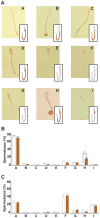Molecular mechanism for human sperm chemotaxis mediated by progesterone
- PMID: 19997608
- PMCID: PMC2782141
- DOI: 10.1371/journal.pone.0008211
Molecular mechanism for human sperm chemotaxis mediated by progesterone
Abstract
Sperm chemotaxis is a chemical guiding mechanism that may orient spermatozoa to the egg surface. A picomolar concentration gradient of Progesterone (P), the main steroidal component secreted by the cumulus cells that surround the egg, attracts human spermatozoa. In order to elucidate the molecular mechanism of sperm chemotaxis mediated by P, we combine the application of different strategies: pharmacological inhibition of signaling molecules, measurements of the concentrations of second messengers and activation of the chemotactic signaling. Our data implicate a number of classic signal transduction pathways in the response and provide a model for the sequence of events, where the tmAC-cAMP-PKA pathway is activated first, followed by protein tyrosine phosphorylation (equatorial band and flagellum) and calcium mobilization (through IP(3)R and SOC channels), whereas the sGC-cGMP-PKG cascade, is activated later. These events lead to sperm orientation towards the source of the chemoattractant. The finding proposes a molecular mechanism which contributes to the understanding of the signal transduction pathway that takes place in a physiological process as chemotaxis.
Conflict of interest statement
Figures






Similar articles
-
Comparative analysis between cyclic GMP and cyclic AMP signalling in human sperm.Mol Hum Reprod. 2004 Jul;10(7):543-52. doi: 10.1093/molehr/gah065. Epub 2004 Apr 30. Mol Hum Reprod. 2004. PMID: 15121877
-
Progesterone activates the principal Ca2+ channel of human sperm.Nature. 2011 Mar 17;471(7338):387-91. doi: 10.1038/nature09767. Nature. 2011. PMID: 21412339
-
Nitric oxide stimulates human sperm motility via activation of the cyclic GMP/protein kinase G signaling pathway.Reproduction. 2011 Jan;141(1):47-54. doi: 10.1530/REP-10-0151. Epub 2010 Oct 21. Reproduction. 2011. PMID: 20965947
-
Phosphodiesterase regulation of alcohol drinking in rodents.Alcohol. 2015 Dec;49(8):795-802. doi: 10.1016/j.alcohol.2015.03.007. Epub 2015 May 29. Alcohol. 2015. PMID: 26095589 Free PMC article. Review.
-
[Chemotactic behavior of sperm].Seikagaku. 2004 Jan;76(1):45-50. Seikagaku. 2004. PMID: 14992081 Review. Japanese. No abstract available.
Cited by
-
Expression pattern of olfactory receptor genes in human cumulus cells as an indicator for competent oocyte selection.Turk J Biol. 2020 Dec 14;44(6):371-380. doi: 10.3906/biy-2003-79. eCollection 2020. Turk J Biol. 2020. PMID: 33402864 Free PMC article.
-
Gamete activation: basic knowledge and clinical applications.Hum Reprod Update. 2016 Jun;22(4):420-39. doi: 10.1093/humupd/dmw014. Epub 2016 Jun 8. Hum Reprod Update. 2016. PMID: 27278231 Free PMC article. Review.
-
Sperm selection by the oviduct: perspectives for male fertility and assisted reproductive technologies†.Biol Reprod. 2023 Apr 11;108(4):538-552. doi: 10.1093/biolre/ioac224. Biol Reprod. 2023. PMID: 36625382 Free PMC article.
-
Cyclic Nucleotide-Specific Optogenetics Highlights Compartmentalization of the Sperm Flagellum into cAMP Microdomains.Cells. 2019 Jun 27;8(7):648. doi: 10.3390/cells8070648. Cells. 2019. PMID: 31252584 Free PMC article.
-
Stromal cell-derived factor 1 regulates in vitro sperm migration towards the cumulus-oocyte complex in cattle.PLoS One. 2020 Apr 30;15(4):e0232536. doi: 10.1371/journal.pone.0232536. eCollection 2020. PLoS One. 2020. PMID: 32353075 Free PMC article.
References
-
- Eisenbach M, Giojalas LC. Sperm guidance in mammals - an unpaved road to the egg. Nat Rev Mol Cell Biol. 2006;7:276–285. - PubMed
-
- Teves ME, Barbano F, Guidobaldi HA, Sanchez R, Miska W, et al. Progesterone at the picomolar range is a chemoattractant for mammalian spermatozoa. Fertil Steril. 2006;86:745–749. - PubMed
-
- Austin CR. The “capacitation” of the mammalian sperm. Nature. 1952;170:360. - PubMed
-
- Chang MC. Fertilizing capacity of spermatoza deposited in the fallopian tubes. Nature. 1951;168:997–998. - PubMed
Publication types
MeSH terms
Substances
LinkOut - more resources
Full Text Sources

